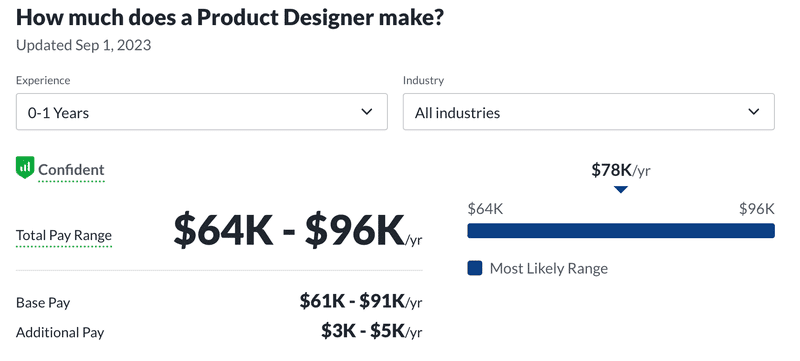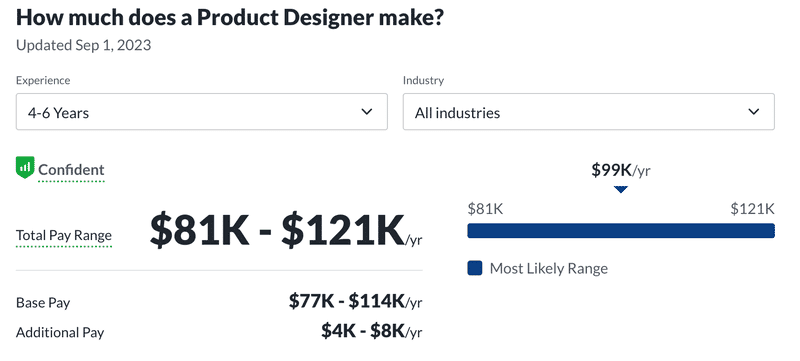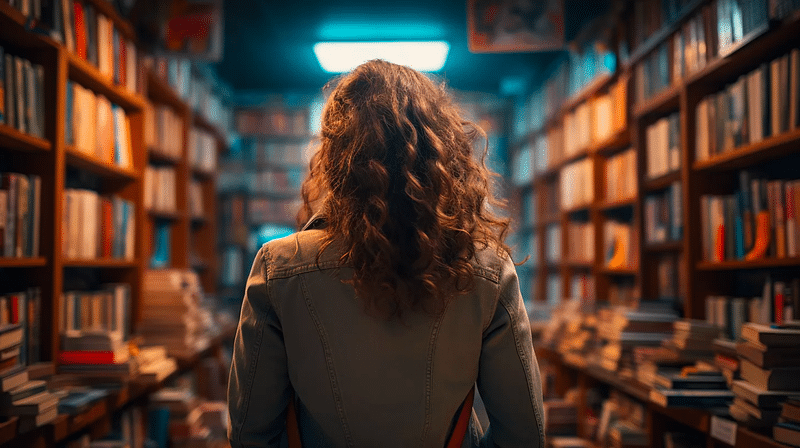Have you ever felt that itch, that urge to dive into unknown territories, even when the comfort of the familiar calls you back?
In the vast universe of design, this crossroads is a common scenario. On one side, the familiar world of Graphic Design with its established traditions and techniques. On the other, the promising and enigmatic realm of UX and Product Design, where innovation, technology, and research reign supreme.
Bianca*, a gifted designer, found herself at this very turning point. Although skilled in graphic design, she felt the need for something deeper, something beyond aesthetics, offering new challenges and fresh professional and personal experiences.
When she decided to delve into the world of UX and Product Design, she opened doors and pathways she could never have imagined had she stayed in her comfort zone as a Graphic Designer.
From the moment Bianca focused on our training program in UX and Product Design (Mastering Interface Design), both her mindset and opportunities more than doubled. So much so, her first achievement in the field was a role as Lead UX/UI Designer for an American company, working remotely from her home in Brazil. This was in a pre-pandemic scenario where remote roles weren't as prevalent in the market.
But Bianca's journey had only just begun with that achievement. The field of UX and Product Design resonated so deeply, and her passion grew exponentially, that she aspired to even greater heights.
Today, Bianca is a digital nomad. Meaning, she works from anywhere in the world, for any company. She has an extensive list of places she's visited within Brazil and is now venturing into international challenges, settling in Prague, Czech Republic, and working remotely for an innovation consultancy in London, UK. It's worth noting that Bianca doesn't hold dual European citizenship. It was her design career that enabled her to secure a visa to live and work in Europe.
Bianca's achievements were only possible because she fully embraced and dived headfirst into the world of UX and Product Design, being a student in our Mastering Interface Design program and our mentorship program Designer Without Borders.
We know the desire to transition to UX and Product Design is strong, but it's not always easy to start. The story we've shared is about Bianca, but it could very well be yours. It all depends on your decision to begin and to persevere!
In this sense, every achievement counts! So, congratulations on deciding to start your journey into the world of UX and Product Design by reading this material.
Upon completing this ebook, you'll be equipped to craft your action plan to build your success story in UX and Product Design.
Without panic, without anxiety, but with preparation and planning, to achieve geographic and financial freedom to travel, explore new places, and live the life you deserve. In addition to securing a solid career with growth potential, being more valued by employers and clients, and crafting products that enhance countless lives.
Shall we begin this journey?
*Name changed to maintain the privacy of our student.
Why do you want to transition to UX Design?
Are your reasons clear?
Usually, when we have such thoughts, we're not content with our current field, leading us to seek better opportunities. But what's your reason?
These are the main motives that drove many of our students to make this decision:
- Current field in decline;
- Higher financial gain prospects;
- Working remotely;
- Working abroad.
There are several factors that can aid your decision. Perhaps at some point, you've realized your current field isn't booming in the market and lacks growth prospects. This might drive you to seek something better.
Additionally, it's essential to consider if your earnings cover your costs and the lifestyle you desire. Can you live comfortably with what you earn? This question is crucial since we need to earn well doing what we love. Working from home can be a game-changer for those wanting to work in UX.
Beyond that, it offers the chance to undertake projects for overseas companies, which can be fantastic. The truth is, organizations worldwide are seeking professionals for UX roles.
So if you've made this decision, we can tell you it won't be as straightforward as it seems, but it will be worth it in the end.
Now, to dive right into it, let's do a brief exercise. Grab a piece of paper and a pen. Go on, I'll wait for you here.
Ready?
I want you to set a 10-minute timer on your phone, reflect, and write down answers to the following questions:
- What's your primary reason for wanting to transition to UX Design?
- Are you satisfied with your current financial earnings?
- What do you hope will change in your daily routine in this new profession?
- Do you have international aspirations?
- What do you envision for your future as a Product Designer?
Great! Now that you've started to gain more clarity on your motivations and goals, let's continue reading!
Ask questions that lead you to better answers

Conducting research in the field is crucial for you to understand more about the new territories you'll be exploring.
Having various pieces of information at your disposal will assist you in detailing where you want to go, what you need to do, and how much time will be required.
The initial step is for the person to have an idea of what they want. I say this because, most likely, this will change, and that's okay. Once that individual studies more, becomes more familiar with the field, delves deeper into the topic, and works, this may shift. But the sooner they know what they want, the easier it will be to sharpen their focus. (Felipe Melo Guimarães, mentor, design lead, and founder of Aela)
In this regard, consider including in your research information about:
- What is UX Design?
- What are the possible areas of specialization?
- How much can one earn working in UX Design?
- What does a UX Designer do?
- What is the market I want to enter like?
To help you kick-start your research, we'll provide a summary of the answers to the questions above:
What is UX Design?
When we navigate through an app, a website, or use a digital product, we often don't notice the intricate machinery operating behind that experience. Every element, from the color of a button to the organization of information, is meticulously planned and designed. This thorough process is known as UX Design.
The term "UX" stands for "User Experience". At its core, UX Design is about the relationship between people and the products or services they use, focusing on optimizing this relationship to make it as efficient and enjoyable as possible.
However, contrary to what many might think, UX isn't just about visual or aesthetic design. It's about deeply understanding the needs, wants, and behaviors of users. By doing so, UX designers work to create solutions that address these needs, ensuring that the products are intuitive, useful, and above all, provide a positive interaction.
So, when we talk about UX Design, we're talking about creating connections. It's a job that requires empathy, analysis, and a human-centered approach, always aiming to provide the best possible experience for the end-user.
So, the next time you find yourself navigating an easy-to-use website or marvel at the simplicity of an app, remember that there's extensive research and UX design behind that seamless experience.
- Dive deeper into the topic here: UX Design: What Is UX Design And How To Get Started?
What are the possible areas of work in UX Design?
n the vast universe of UX Design, the range of roles and functions available is remarkable. For those looking to enter or specialize in this field, understanding the varied possibilities is essential to strategically direct their career in line with their own interests.
- UI Designer: Although often confused with UX, UI (User Interface) refers to the visual design and aesthetics of a product. This professional is responsible for creating attractive interfaces, ensuring that visual elements are aligned with the desired user experience;
- UX Researcher: This expert focuses on understanding user needs and behaviors. They conduct studies, interviews, and tests to gather valuable insights that guide product development;
- Product Designer: A versatile professional who encompasses skills in both UX and UI Design, specializing in digital product design. They focus on user-centered design, persona creation, user journey mapping, and interface development. Their competencies range from user research to the creation of prototypes and final interfaces, making them essential in the digital product creation process;
- UX Strategist: With a broader perspective, the UX strategist analyzes the market, competitors, and trends to define design guidelines that align business objectives with user needs.
- Dive deeper into the topic here: UX Design: UX Design: What Are the Possibilities for Working in the Field?
What is the salary of UX and Product Designers?
The compensation for Product Designers is quite attractive, and this is undoubtedly a good reason for many people to consider switching to the profession.
With a search on the Glassdoor.com website, we find that the salary range for those starting as a Product Designer (up to 1 year of experience) is from $64k to $96k per year.
Of course, these figures increase with the level of experience and position, reaching a range of $136k to $216k per year for Senior Product Designers.



It's worth noting that these figures represent the average salary in the United States, which is a vast and diverse country. Depending on the region and the company, the amounts can be even higher.
For instance, some companies might pay well above the average for more experienced designers:

These figures that appear on these specialized websites can be confirmed by looking at our students. We've followed so many students that we know the market really offers good salaries.
Therefore, it's a fact. Good UX Designers earn excellent salaries!
What do UX Designers do?
The UX Designer is essential in the creation of digital products and services that provide pleasant and effective experiences for users. Their responsibilities include:
- User research: Understanding the needs and expectations of users through interviews, analyses, and other forms of research.
- Development of personas: Creating fictional representations of users based on data collected during research.
- User journey mapping: Identifying user touchpoints and interactions with the product, pinpointing pain points and opportunities for improvement.
- Layout and content organization: Determining the arrangement of elements and the flow of information to make it clear and intuitive.
- Prototyping: Developing prototypes to test and validate design solutions.
- Usability testing: Conducting tests with real people to evaluate the product's efficiency and usability.
Depending on what one wishes for, starting the journey to migrate to UX might be challenging. But persistence and dedication make everything easier as one progresses along the path. (Felipe Melo Guimarães, mentor, design lead, and founder of Aela)
- Delve deeper into the topic here: UX Designer: Challenges and Responsibilities
What's the market I wish to enter?
UX and Product Designers operate in various markets and continue to advance as companies undergo digitization.
Therefore, being a UX and Product Designer does not necessarily mean working in a company entirely focused on technology, like Apple or Google.
In fact, it's possible to work in more "traditional" markets such as finance and health, for example.
But since each of these markets has its own dynamics, needs, and distinct characteristics, it's crucial for you to research the ones you're most interested in.
For instance, if you're intrigued by the financial market, it's vital to understand how banks and investment institutions are working with their digital products, how this market operates, and what professionals need to know beyond the concepts of UX and Product Design.
So, researching the markets you'd like to engage in is crucial for specialization and training to secure your opportunity in the field.
Be proactive and ultra-focused in your research:
- Raise questions and seek answers. Talking to people who have already transitioned to UX Design is also a great alternative because they can provide you with a different perspective on the field.
- It's essential to know the position you aim to achieve, so draft a schedule with an estimated timeframe to initiate the career change. Be realistic with your goals and set short-term objectives to achieve daily.
- Making a career change based on emotion can lead to future regrets, so be clear about what you desire in your professional life. Ask yourself: do I genuinely want to become a UX Designer? What do designers do daily? Is this what I want for my life?
Reading Tip: How to Pivot Into a UX Design Career: 10 Initial Steps
Know what you don't yet know

The next step in your action plan is to understand and map out the skills you need to acquire to transition into UX and Product Design.
This step is also part of the research phase, but given its significance — perhaps one of the most crucial steps — it's essential to emphasize it within your action plan.
Here, it's worth noting how a mentorship process or a training program (like the Mastering Interface Design) can assist you in identifying and learning the skills you need to pick up or enhance. Many individuals might have blind spots when trying to pinpoint areas of improvement, which is why assistance in this aspect is always beneficial.
There are basically two types of skills you'll need to develop throughout your career as a UX and Product Designer: technical skills (Hard Skills) and behavioral skills (Soft Skills). Below, we list some of the primary skills you should consider at this transitional phase into UX design.
Hard Skills
- UX Research: Ability to conduct interviews, document and interpret research, perform usability tests, and develop personas.
- UX and Usability Concepts: Knowledge about User-Centered Design and the basic principles of usability are fundamental to start in the career.
- Interaction Design: Understand and create wireframes, prototypes, and user journey maps, always considering how the user interacts with the platform.
- Visual Design: Mastery of design principles such as typography, color palette, visual hierarchy, and responsiveness.
- Information Architecture: Organize and structure information in a way that makes sense to users.
- Design Tool Skills: Knowledge of tools like Sketch, Figma, Adobe XD, among others.
Soft Skills
- Empathy: The ability to put oneself in the users' shoes is crucial. It helps to understand their needs, pains, and desires.
- Collaboration: UX work often involves collaborating with different stakeholders, such as developers, product managers, and even customers.
- Effective Communication: The ability to communicate your ideas and design rationales to non-designers is essential.
- Adaptability: The world of UX is always evolving. Being adaptable and open to new techniques or tools can be a significant advantage.
- Problem Solving: The essence of UX is to solve problems for users. The skill to identify, analyze, and create solutions is key.
- Receptiveness to Feedback: Being willing to accept constructive criticism and adjust projects based on feedback is an essential part of the design process.
- Dive deeper into the topic here: 9 Soft Skills to Stand Out as a Designer and The 8 Essential Skills for a Career in UX/UI Design
Develop and adopt a mindset of continuous learning
Once you understand the main skills needed to transition into UX Design, it's essential to find ways to develop them.
Here, we believe that the most efficient way to learn is through courses and certification programs. Of course, some people might learn through self-study, but this path is more intricate and challenging because you have to deal with issues like:
- Which information sources are reliable?
- What do I need to learn first, and what can I learn later?
- How to validate if I really learned what I read?
When you choose a course or training program, you:
- Have good sources of information (Bibliographic references)
- Follow a study program (lessons and modules)
- Have teachers and mentors to provide feedback
Therefore, the recommendation will always be to look for good courses and serious institutions that can efficiently provide you with knowledge.
In this context, we must mention that Aela offers a training program in UX and Product Design, the Mastering Interface Design (MID), as already mentioned here.
In MID, you'll have the guidance of mentors with over a decade of professional experience, will carry out practical projects to build your portfolio, and will have the chance to join the student community where you can ask questions and share concerns and achievements.
Learn more about our program and apply at the link below:
Create a study-friendly routine and overcome procrastination

Even if you choose a course or training program, it's not enough just to watch the classes, right? It's essential to commit and study the materials and content.
Therefore, an essential step in your plan to transition to UX Design is to organize and build a study plan tailored to your needs.
For that, consider:
1. Assessing Available Time
First and foremost, dive into your routine. Life is full of obligations, but for an effective transition to UX Design, it's crucial to dedicate consistent time to studies. The key is to analyze your routine and identify blocks of time where you are most inclined to learn. Be realistic: consider all your responsibilities and adjust accordingly. An effective strategy is to break down your study time into short and consistent sessions.
2. Defining Essential Topics
UX Design is vast, with multiple interconnected topics. The pillars to start include:
- Basic concepts of UX and Product Design;
- Fundamentals of Interface Design;
- Processes and Research Methods in UX.
Determine the study order based on your personal goals, starting with the basics and moving on to specific topics of interest.
Here, use the study program of the course you are taking as a base to know what to prioritize in your studies.
3. Learning Strategies
Identifying the learning method that resonates with you is crucial. Some strategies include:
- Reading: Essential for theory.
- Summaries and Mind Maps: For consolidation and review.
- E-learning: Learn at your own pace with interactive platforms.
- Practice: Implement your knowledge in real projects.
- Group Discussions: Share and gain valuable insights.
Try combining various strategies for better information retention.
4. Study Schedule
A well-structured plan is key. Consider:
- Structuring: Base it on your goals, topics to study, and time availability.
- Flexibility: Life is unpredictable; be ready to adjust your plan when necessary.
- Rest and Monitoring: Give your brain time to assimilate and regularly check your progress.
Having a study plan helps you maintain consistency and overcome the bumps along the way. Knowing what you have to study and dedicating time to it helps keep procrastination at bay.
Controlling your money gives you freedom and security

Considering a career change is a significant decision in people's lives, and its impact also extends to financial life.
Investing in courses, tools, or even deciding to leave a job and dedicate oneself entirely to studies are situations that require efficient financial organization.
Therefore, in your action plan to transition to UX Design, consider setting up a financial plan that includes:
- Assessing your current financial situation: Familiarize yourself with your monthly expenses, categorizing them into fixed (e.g., rent, insurance) and variable (e.g., food, entertainment) expenses. Use a spreadsheet to record these expenses, compare them to your monthly income, and identify how much you can save for the career transition.
- Expense optimization: With a clear expense mapping, identify areas where you can save, such as reducing outings to restaurants, optimizing subscriptions and services, and making smart purchases.
- Emergency fund: Before starting the transition to UX Design, build a financial reserve to cover unexpected expenses, ensuring immediate liquidity.
- Specific UX financial reserve: Parallel to the emergency fund, establish a reserve to cover costs related to the transition, such as courses, tools, and events.
- Mapping UX investments: Identify and estimate the expenses needed to transition to UX Design, including training, participation in events, tools, and equipment updates.
- Setting financial goals: Create clear and realistic goals to guide and motivate your financial planning, ensuring that you are prepared for the career transition.
Having secure finances brings more peace of mind and focus for you to study and make a career move into UX Design.
- Dive deeper into the topic here: How to Successfully Transition to UX Design: A Financial Guide
Defining Your Transition Plan for UX Now
Now that you've done your research and organized yourself, it's time to lay out your plan to transition to UX Design.
First, estimate how long it will take you to be working in the field. Then, break down the activities required to reach that goal, considering the dates backward. Let's look at an example to make it clearer.
If you estimate you want to be working in the field as a Product Designer for a financial market company in two years, you should determine your activities to reach that goal based on that estimate. So, your plan would look something like this:
- May 2025: Secure a position at a FinTech as a Junior Product Designer (goal).
- Feb/25 to May/25: Start sending out resumes for opportunities.
- Dec/24 to Jan/25: Structure and enhance the portfolio.
- Oct/24 to Nov/24: Develop academic projects to set up a portfolio.
- Jun/24 to Sep/24: Study User Experience, Research, and Strategy.
- Jan/24 to May/24: Study User Interface for Web and Desktop.
- May/23 to Dec/24: Study introductory concepts of Product Design.
This example is quite simple, just to show the logic of building the schedule backward. However, many of our students achieved the results they sought by following exactly these steps that Felipe gives in mentoring at the beginning of their studies.
When the objective is put first, it becomes easier to understand and define the preceding steps, and thus, build a more accurate plan.
It's possible to break down the timelines even further. For example, in the study section, you can establish what to study each month and even set weekly study goals.
Here, alignment with the study plan is essential. It's crucial to consider the hours and days you have available to study.
Don't forget: it's vital to stay grounded when building your plan and schedule.
When creating your plan, the most important thing is to look to the future and take steps backward. If you're just starting and envision yourself working in the field in 2 years, that's your future. So on date X, I will be working in an office, or at home, or as a freelancer. I have 2 years to achieve this goal. (Felipe Melo Guimarães, mentor, design lead, and founder of Aela)
How to Show Your Knowledge to the World?

After completing your studies and mastering the knowledge in UX and Product Design needed to change careers, you — now indeed — need to build your portfolio.
For the first portfolio, it's quite common to undertake academic projects, meaning exercises that simulate real projects. Although they might seem "not very convincing," well-executed academic projects can indeed impress recruiters and secure an opportunity in the field.
It's essential to remember that, in terms of portfolio, quality surpasses quantity. Having 3 high-quality and impactful projects is more effective than having many low-quality ones. Focus on including only your best work, those that consistently showcase your skills and achievements.
Another vital point to remember is that the portfolio projects should reflect your knowledge in UX and Product Design. It's very common for people coming from Graphic Design to believe they can compose a UX portfolio without studying. Don't buy into this; don't make that mistake!
- Delve deeper into the topic here: 7 Mistakes to Avoid In Your UX Design Portfolio and UX Design Portfolio: 6 Essential Tips for Building Yours
Raise Your Flag and Let the World Know
In addition to doing your research and setting up your plan, you also need to broadcast your interest through the available media channels.
To do this, use social media to inform your friends and colleagues that you're transitioning fields, make new connections with those already working in the area, and promote your profile.
Knowing how to use these networks will be of great importance to you. Corporate social media can also broaden your opportunities. Show that you are available in the market and that you're studying the subject. Networking is the best way to expand your personal and professional relationships.
How long does it take to get hired?
There's no fixed timeframe; it all depends on your dedication and persistence during your studies and when promoting yourself on social media. LinkedIn is a fantastic platform for showcasing your work.
There are individuals who secured their first opportunity in less than a year after completing our training, so the exact time can vary. One aspect that will significantly attract recruiters' attention is your portfolio.
A portfolio reflects the ideas and projects you'll carry out as a UX Design professional. It will assist you during your hiring process and will be your most crucial tool for showcasing your work.
If your portfolio is already well-structured, it's a good idea to share it on your social media platforms. Remember when we discussed networking? Now, it will be a significant asset to help disseminate your work to reach major companies.
Be clear about what you don't want

Just as it's essential to select what we want to do, we need to list things we don't want. By doing this, we eliminate the chances of working in areas we dislike.
Disliking a specific role is entirely normal; we are all different and may be more suited to some positions than others. It's essential to be clear about what you dislike because it will help you focus on what you enjoy.
We know that in many cases, we don't get the opportunity to start working in our preferred role immediately and choose to work in a different area for a while.
It's generally not easy to start in the desired area, and the reason is simple: lack of experience, certification, among other things.
I've heard some people say they didn't want to work with anything related to the financial market. As a result, all their studies and projects will point in a different direction. (Felipe Melo Guimarães, mentor, design lead, and founder of Aela)
If you genuinely dislike an area, don't waste time on it, direct your efforts and projects towards what you love. This attitude may cause you to miss some job opportunities initially, but if you can choose, it's always better to seek something you like from the beginning.
Unless you're in dire need of money, in which case you'll accept. Otherwise, you'll continue looking for a position in your desired field.
Consistency and patience are the keys to success
Patience is one of the most critical attributes out there, but we rarely master it. That's because we always want everything immediately, especially what we are obsessed with.
Often, we don't respect the timing of events, leading to feelings of frustration, sadness, and a lack of hope. One of the reasons for this issue is the distractions we find everywhere.
It's straightforward to get caught up with internet videos or fiddle with our phones, just wasting time that could be focused on studying.
Having patience is about recognizing where we are, understanding where we want to go, and plotting a course to achieve that goal.
We always want things, and we want them fast. Typically, the patience we have is for something we don't care about much. The more we want something, the less patient we become. If someone can focus and introspect during their study time, they will progress further. (Felipe Melo Guimarães, mentor, design leader, and founder of Aela)
The balance for patience must be struck. If you're committing to studying a topic within a defined period, aim to give it 100% of your attention and focus. Seek concrete information about your field, and instead of chasing 20 or 30 different references, concentrate on one or two.
Make your plans, but proceed one day at a time, stay calm, and set a daily goal for your study topics. Otherwise, everything will start to feel too overwhelming, and you'll get lost amid the content.
We can assure you that if you follow these steps with determination towards the goal you seek, things will turn out right in the end.
Reading Tip: "Studying in Partnership Helped Me Switch to UX Design – Interview with Giulia Pignati
No one does anything alone…

Having the support of parents or family members at this time can be crucial, especially to help during the challenging times you'll face. Sometimes we need to take a break to be with the people who love us; only then can we recharge and continue pursuing our goals.
The process of transitioning to UX is not straightforward, and we won't always be 100% motivated. Family and friends play a vital role in restoring our mental health for our learning, so be close to your loved ones when things are tough.
In most cases, people work while they are seeking this career change. That's because they can't afford to leave their current job and be without means to pay their basic bills.
If this isn't your situation and you still live with your parents, it's important that they can provide you with financial support during this process, as you will need to pay for the courses you'll take. It's crucial for them to help, at least until you can work in the field and achieve financial stability.
Reading Tip: Family Support Was Essential for My Transition to UX Design – Interview With Erivelton Santos
Accelerating Your Process and Results
Switching to UX demands a life change. You need to be sure about the choices you're going to make to avoid future regrets. So the question remains: do you genuinely wish to transition into UX?
Sometimes we get emotional about some stories we see on television, and we're swept up by this feeling, but in reality, things aren't always like that. We need to be genuinely invested in the decision we're about to make.
If you've read this content up to this point, rest assured, you've already started taking the initial steps of your journey. Now, outline your career plan and make your transition as soon as possible.
One genuinely has to be into it. For instance, if someone hears on the news that UX is the trending field and gets excited because of the salary, that person tends to give up faster. (Felipe Melo Guimarães, mentor, design leader, and founder of Aela)
UX Design is a field with ample opportunities and is continuously evolving. UX Designers earn great salaries, but you genuinely need to want it. We shouldn't work in the field just because of the high pay or the possibility of remote work; we need to enjoy what we're doing.
If we're working in an environment we dislike, the chances of giving up become significantly higher.
So, think thoroughly, research, and draft an action plan, considering the items and questions discussed in this article. We're confident it'll guide you towards achieving your goal of transitioning and working in UX Design.
To assist you in this career transition, I invite you to join our training program in UX and Product Design, the Mastering Interface Design (MID).
With MID, you'll start studying from scratch, acquiring the necessary knowledge to become a UX and Product Designer.
You'll learn not just the theory but also put all that knowledge into practice. At each level of the program, you'll undertake a project to be approved by our team of mentors. Each project can be used to compose your initial portfolio in UX and Product Design.
With MID, you'll be mentored by a team of experts and follow a proven methodology that has already helped hundreds of individuals secure their positions in companies like Meta, Uber, Booking, Siemens, IBM, Accenture, Zalando, N26, GoodNotes, Thoughtworks, and many others.
We're confident that MID will assist you as well.
Learn more by accessing the link: Mastering Interface Design
What you should do now (if you haven't already)
To recap, to set up your plan you should now:
- Conduct research on the field and the market, and clarify all doubts about the profession;
- Identify the skills and knowledge you need to develop to transition into UX and Product Design;
- Look for a course or certification program to help you acquire the necessary knowledge;
- Set up a study routine;
- Organize your finances;
- Draft a schedule for your action plan;
- Build a portfolio;
- Seek family support and build networking;
- Trust the process and don't give up!
- Send us a message on Instagram sharing your stages and outcomes! We'd love to follow along and help you reach even greater heights.








